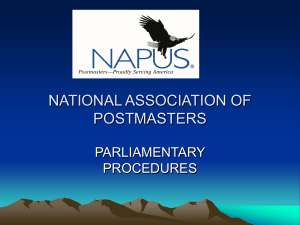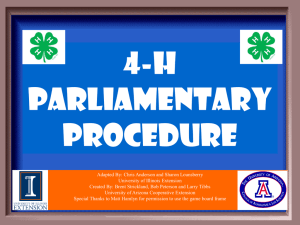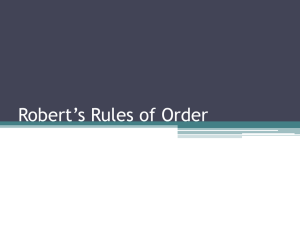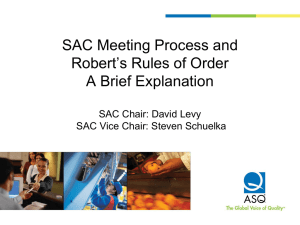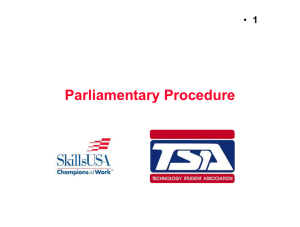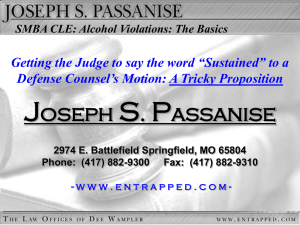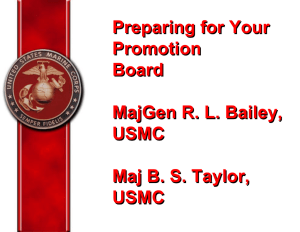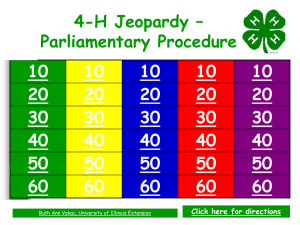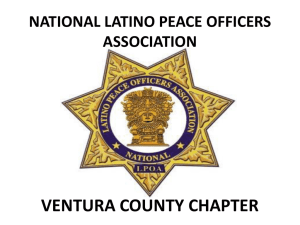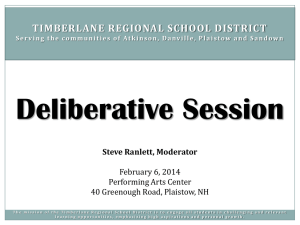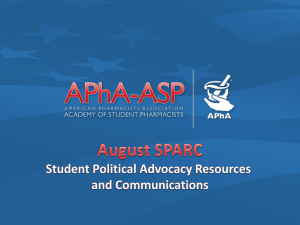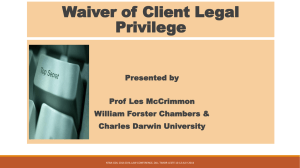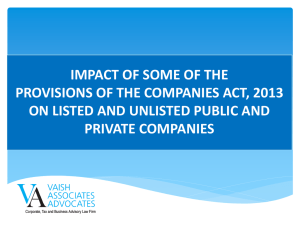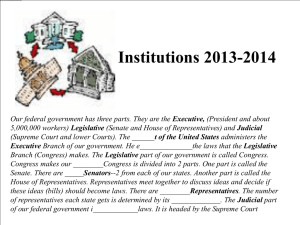WMY 2013 – Parliamentary Procedure
advertisement
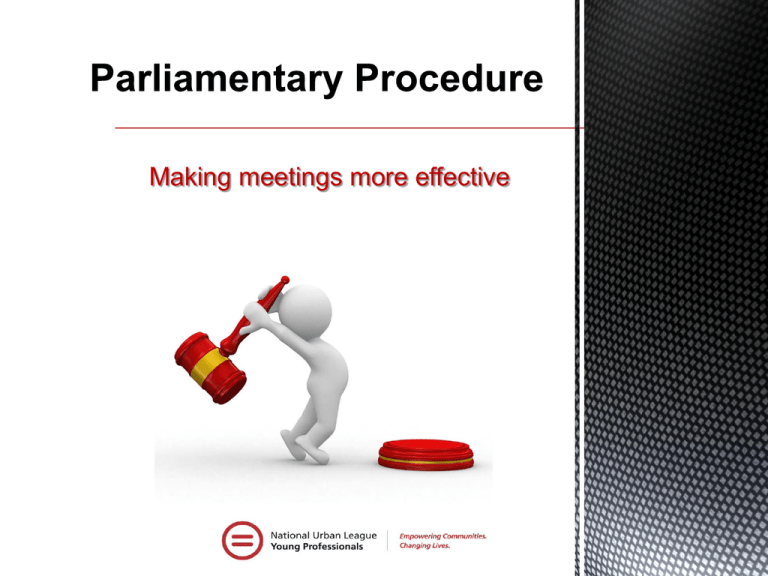
Making meetings more effective 1. 2. 3. 4. 5. State the purposes of following parliamentary procedure. Recognize the five basic principles of parliamentary procedure. Identify steps involved with presenting a motion. Recognize various methods of voting. Differentiate the types of motions. Purposes of Parliamentary Procedure 1. 2. 3. 4. 5. To give every member a chance to be heard. To allow everyone to participate. To establish and maintain order in a meeting. To prevent confusion when discussing meeting’s agenda. To keep meeting moving. Principles of Parliamentary Procedure 1. 2. 3. 4. Discuss one subject at a time. Allow full and free discussion of each idea presented. Treat all members with justice and courtesy. Carry out the rule of the majority, and respect the rights of the minority. 5. Bring together the wishes of all group members to form a cooperating, united organization. Official Rule Book is Robert’s Rules of Order, Newly Revised. Written by U.S. Army general Henry Martyn Robert. What is a quorum? ½ of the members in a chapter plus 1. Minimum number of members that must be present at a meeting for legal business to be transacted. What is a majority? ½ of members present at any meeting plus 1. Minimum number of members that must vote for a motion for it to pass. Presiding Officer referred to as: Mr./Madam President Mr./Madam Chairperson Everyone gets a chance to voice their opinion or debate. Everyone gets the chance to vote Must be a yes or no vote. There are four methods of voting. Voice Standing Roll Call Secret Ballot Can the chairman (president) vote? YES, in order to force a tie or to break one if they are a member of the group. When secret ballot is used. Only one topic at a time can be discussed. The person who makes a motion has the right to discuss it first. The Gavel A symbol of power and authority. Used by the presiding officer to give instructions to the members. The number of taps have a specific meaning. One Tap Follows the announcement of adjournment. Completion of a business item. Members to be seated. Two Taps Call the meeting to order. Three Taps All members to stand. Series of Taps Restores order to a meeting. A meeting should have a set agenda. Purpose is of the Order of Business (Agenda) is to keep the meeting moving forward. The agenda forms the framework for the development of a good business meeting Call to Order by the President & the opening ceremony by the ULYP officers. Minutes of previous meeting read by the Secretary and approved by the body in accordance to organizational by-laws and parliamentary procedure. Treasurer reports on the financial standing of the chapter. Report on Chapter program of Activities (by officers and committee chairmen). Unfinished (Old or Continuing) Business (Business leftover from the previous meeting) New Business (Presented by members in the form of motions) Adjournment & Closing Ceremony How does one conduct the meeting as it is laid out in the order of business (Agenda)? Order of Business (Agenda) handled by using various motions and rules governing them which are part of parliamentary law. Main Motions Privileged Motions Incidental Motions Subsidiary Motions Motions That Bring a Question Again Before the Group A motion is a formal way to bring an idea, proposal, or plan of action before a group. A motion is part of an orderly way to conduct business using parliamentary procedure. A motion calls for discussion and action by the group. 1. A member who wants the organization to do something makes a motion by addressing the presiding officer. 2. The member must be called on by the presiding officer. 3. The member makes a motion by saying, “I move… 4. The motion is then seconded by another member. 5. The presiding officer restates the motion and asks for discussion. 6. Discussion is held on the motion. 7. The presiding officer repeats the motion and says, “Are you ready for the question? All in favor say Aye; all opposed say No.” 8. A vote is taken to ask who is in favor of and who is opposed to the motion. 9. The presiding officer announces the result and declares, “The motion is passed.”-OR- “The motion is lost.” Main Motions A main motion introduces a new item of business, the matter to be considered by the group. It can be ruled out of order if it conflicts with the organization’s by-laws, constitution, standing rules or any resolution already agreed upon. Only one main motion can be considered at a time. CHARACTERISTICS • Lowest-ranking motions • Cannot be made when another motion is being considered • Yield to subsidiary, incidental, and privileged motions • Cannot be applied to any other motion, but other motions can be applied to it CHARACTERISTICS • Can be amended in five different ways, debated, divided, laid on the table, objected to, postponed, reconsidered, referred to committee, renewed (if rejected), rescinded (after approval), seconded, terminated, voted on, withdrawn • Require majority vote • A vote on a main motion is not valid when it supersedes the rights of members, in which case a two-thirds vote is needed CLASSIFICATION OF MAIN MOTIONS • Resolutions • Original main motions • Incidental main motions RESOLUTIONS • Resolutions are a type of main motion. Resolutions and main motions differ only in their format. • All resolutions are main motions, but not all main motions are resolutions. • Resolutions usually state a policy, principle, feeling, or sentiment. They tend to have explanatory preamble that usually begins with the word whereas, which serves a bridge to introduce the explanation for the resolution. ORIGINAL MAIN MOTIONS • An original main motion presents a new topic for debate or discussion. I move that our cooperative invest in the Cooperative Bank of Misamis Oriental. INCIDENTAL MAIN MOTIONS • An incidental main motion is tied into events before the assembly. • Unlike a main motion or a resolution, it does not initiate business. • Like a main motion or a resolution, an incidental main motion can only be proposed when there is no other motion on the floor. TYPES OF INCIDENTAL MAIN MOTIONS • Adjourn • Adopt a matter previously considered • Adopt a report (accept, agree to) • Adopt by-laws • Adopt constitution • Adopt agenda • Adopt standing or special rules • Amend agenda • Amend rules TYPES OF INCIDENTAL MAIN MOTIONS • Annul or rescind or repeal • Approve the minutes • Confirm or ratify • Discharge a committee • Extend debate • Nominations • Order of the Day • Question of Privilege • Recess • Voting Main Motions that are not legal: Break any local, state, or national law. One that brings up a previously failed motion. Items that are out of the power of the group. Negative motions. Political & religious support. The person who makes a motion cannot speak against it. Main motions can be reconsidered. Cannot interrupt another speaker. Proper Example: Mr. President, I move that the chapter hold a cookout for all ULYP members. Before another motion can be made, a motion that is seconded must either be: • Voted on • Withdrawn • Amended • Tabled Both the person who made the motion and the person who seconded the motion must agree that it be withdrawn. Privileged Motions A privileged motion deals with a special matter of pressing importance and does not relate to the business on the floor. Privileged motions are the highest ranking motions, taking precedence over all other motions. They can interrupt any business on the floor, without requiring debate or discussion. Types of Privileged Motions MOTION DESCRIPTION Adjourn Ending the meeting Call for the Orders of the Day Requiring the agenda be followed Fix the Time to Which to Adjourn Setting the time for the next meeting Question of Privilege Allowing members to make urgent requests about the rights of the assembly and its members Recess Taking a short break in a meeting Incidental Motions An incidental motion comes from another motion. It is always directly related to the business on the floor. CHARACTERISTICS • Incidental motions take precedence over main motions and subsidiary motions but yield to privileged motions. • They must be decided before the meeting can continue. • They must be decided before other motions. • They cannot be amended. • They cannot be debated, except for the motion to Appeal. MOTION DESCRIPTION Appeal Challenging the Chair’s ruling Consideration by Paragraph Separating a long document or motion into different parts and voting on each part separately Division of the Assembly Calling for retaking a vote Division of a Question Separating the main motion into different parts to vote on each part differently MOTION DESCRIPTION Objection to the Consideration of a Question Avoiding motions that are off the topic or disruptive Point of Order Compelling the Chair to adhere to the rules of the assembly Request (Parliamentary Inquiry, Point of Information, Reading Papers) Making inquiries about the business at a meeting and asking permission for meetingrelated activities Suspend the Rules Temporarily setting aside the organization’s rules Subsidiary Motions A subsidiary motion is linked to a main motion to aid in its disposition. Subsidiary motions can be made while a main motion is still being considered. CHARACTERISTICS 1. A subsidiary motion can never stand alone. It is always applied to another motion. 2. It always changes the status of the motion to which it is applied by modifying it in some way. 3. It must be decided before the assembly can act on the main motion. MOTION DESCRIPTION Amend Tailoring a motion to be more specific and acceptable Commit to Refer Sending a motion to a committee for further study Lay on the Table Setting aside a main motion to deal with more urgent business Limit or Extend Debate Decreasing or increasing the time to debate an issue MOTION DESCRIPTION Postpone to a Certain Time Moving consideration of the motion to a later time Postpone Indefinitely Removing the motion from consideration during the current meeting or session Previous Question Closing debate and forcing an immediate vote on the motion Motions That Bring a Question Again Before the Assembly Purpose: To reevaluate a decision made earlier. Requires a second Not amendable Debatable Majority Vote Cannot interrupt another speaker If passed, the motion to be reconsidered is handled as if it were never voted on. Can only be made by a person who voted on the winning side. If passed, the motion is handled immediately if: Only a main motion with amendments is on the floor. Handled after the current business if: Discussion on refer to committee or postponement has been started. Motions that can be reconsidered: Main Motions Amendments Refer to Committee Postpone Definitely Previous Question Extend/Limit Debate Appeal Fix Time to Adjourn Motions that can be reconsidered if they passed: Postpone Indefinitely Motions that can be reconsidered if they failed: Object to Consideration of Question Rescind Proper Example: Mr. President, I move to reconsider the motion to have a cookout on March 1st for all ULYP members. Purpose: To repeal a previous action. Requires a second Amendable Debatable 2/3 Majority Vote without prior warning Cannot interrupt another speaker Proper Example: Mr. President, I move to rescind the motion adopted at the January meeting have a cookout on March 1st for all ULYP members. Purpose: To take a motion that is on the table off of the table. Requires as second. Not amendable Not debatable Majority Vote Cannot interrupt another speaker Proper Example: Mr. President, I move to take the motion that the chapter have a cookout for the members off the table. Voice Vote Show of Hands Rising to Vote Ballot Vote The chair asks those in favor to say, “Aye” or “Yes.” Those who are opposed are asked to say, “Nay” or “No.” This method is recommended for small groups. The Chair asks members who are in favor to raise their right hands. After the count is taken, those who are opposed are then asked to raise their right hands. This method should be used to verify a voice vote and on motions requiring 2/3 majority vote. Chair asks those in favor of the motion to rise. After counting, these members are asked to sit. The chair then asks those opposed to rise. This method involves writing a vote on a slip of paper. This is a good way to vote for officers, or to vote upon controversial motions. The chair should appoint individuals to distribute, collect, and tally the ballots. The Chair only votes: • In the event of a tie • To make a vote a tie • When secret ballot is used • When he is part of the assembly Call to order (two taps of the gavel) Pledge of Allegiance (three taps of the gavel to stand, one to sit) Roll Call Reading and Approval of minutes Reports Unfinished Business New Business Announcements Adjournment (one tap) There can only be one MAIN MOTION on the floor at one time. A member CANNOT TALK against his own motion, but he CAN VOTE against it. A vote that is tied fails. Only qualified members are allowed to vote. The Chair may ask for a standing vote when: 1. A 2/3’s vote is needed (suspend the rules, close nominations, previous question, rescind a motion) 2. Someone has called for a division. Presenter: CARLOS J. CLANTON Mobile Phone: 757 695 8399 Fax: 757 628 3939 Email: procedures@nulyp.net Web: www.carlosclanton.com
